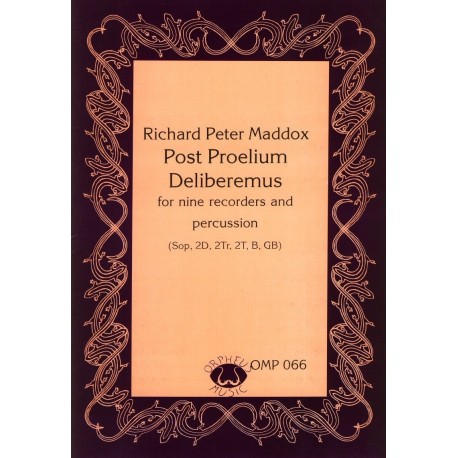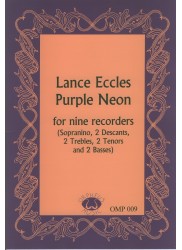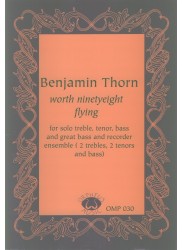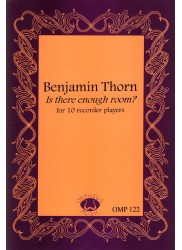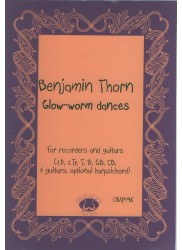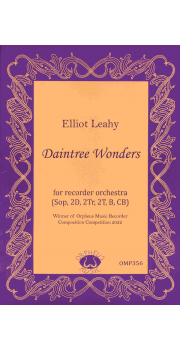No products
Prices are tax included
Post Proelium Deliberemus
OMP066.pdf
PLEASE NOTE - DOWNLOADABLE PDF VERSION
Composer: Maddox - Richard Peter
Instrumentation: Sopranino - 2 Descants - 2 Trebles - 2 Tenors - Bass - Greatbass
Period/genre: Australian Contemporary
Grade: Moderate - Difficult
More info
*Contemporary Piece.* An exciting piece with solo sopranino part, that combines a strong melodic impulse with various rhythmic approaches.
1. Post Proelium Deliberemus
Please note that due to the automated delivery of virtual products including pdf downloads, PayPal payment is required at the checkout - we are unable to accept the cheque payment method for these items.
_Score 20 pp. Parts 3-4 pp. Downloadable PDF file - 1860 Kb._
OMP066 Richard Peter Maddox Post Proelium Deleberemus
This is most definitely the piece for every advanced recorder ensemble with an inspiring virtuoso sopranino player!
Although entitled "for 9 recorders and percussion" this piece could really be described as an octet with percussion plus solo sopranino line - most definitely not for the faint hearted. The sopranino line would take a very competent player with secure technique to produce a convincing performance. Prepare yourself for semiquavers in A Major at crotchet =132 - not everybody's cup of tea.
The rest of the ensemble themselves are taxed in different ways. Ranging from divisi descant/treble/tenor to bass and great bass, the extended recorder family is taken through its paces and ensemble skills are tested.
Following a short Prelude entitled "Chaos" ("Each instrument in independent free rhythm"), the main body of the 1st movement, "Triumph" opens in a jaunty 10/8 time signature (3+2+2+3) which in itself poses ensemble problems. The 2nd movement, entitled "Deliberato" requires excellent tuning and rhythmic skills from all whilst supporting a haunting sopranino line above, whilst the 3rd movement, entitled "Laetitia", again provides some rhythmic complexity as well as frequent chromatic movement through keys.
A demanding piece which will require some preparation by the sopranino player and will hopefully provide many weeks of concentrated rehearsal time - enjoy it!
Jean McCreery, The Recorder Magazine, Winter 2001
OMP066 Richard Peter Maddox Post Prolelium Deliberemus
Latin passed me by at school but a Latin/English web site helped me ascertain that Post Prolelium Deliberemus is something to do with a battle (there is no programme note, which would have been useful). There is an opening section of Chaos, where the instruments have to play in free rhythm (the battle?), followed quickly by a Triumphus (hurrah, we've won the battle?); the second movement is marked Deliberatio (let's reflect seriously on what has been won?) and the third Laetitia (let's party?). The approach is more adventurous technically than in Deep Sea Perspectives although I don't always find the musical style convincing; in the first movement especially the sections follow each other awkwardly and the central, pseudo-fugue seems contrived. The last movement will be fun, however; the syncopated rhythms provide a good test of ensemble and the soprano part, dashing about at high speed in a series of scalic and arpeggiated interjections, offers a virtuosic challenge to the would-be soloist. This is clearly the harder of the two pieces and would need a willing and dedicated ensemble to do it justice.
Both pieces provide good, and much needed, ensemble material for young players but, of the two, Thorn's Deep Sea Perspectives will prove most musically satisfying to both players and audience.
Donald Bousted, Cinnamon Sticks, May 2002
OMP066 Richard Peter Maddox, Post Proelium Deliberemus
...Richard Peter Maddox's, Post Proelium Deliberemus (deliberations after the battle)... mixes modern day aleatoric procedures and minimalism with aspects of Baroque form and style, using a conservative tonal language. Though he employs a wide range of recorders, most of the activity occurs in the upper parts, with the sopranino taking a concertant role.
The first movement beings with a bit of bombast. After a chaotic aleatoric opening, a dense, repetitive minimal music section leads to a brief, out-of-key fanfare. The main body of the movement consists of a fugue that is twice interrupted by what might best be described as an imitation Vivaldi sopranino concerto.
The second movement is a slow aria for the sopranino set over the incessant repetition of a C Major chord, by the recorder ensemble. The sopranino is again in a concertant role in the fast final movement, playing a melody that may have some Vivaldi-like contours but, in a general way, resembles "The Sailor's Hornpipe." As in the second movement, the recorder ensemble serves as a subordinate backdrop. Unlike in the other movements, where the percussionist plays simple ostinato patterns on two tom-toms, the drums here are exclusively featured in a brief, loud solo gesture that perhaps might be a reference to gunfire in a battle. This gesture appears as an interjection at cadence points. It is shocking on first hearing, but after a while becomes progressively predictable, then ridiculously funny. It appears a dozen times!
Pete Rose, American Recorder, March 2003
11 other products in the same category:
Reference: OMP009
Brand: Orpheus Music
Purple Neon
Composer: Eccles - LanceInstrumentation: Sopranino - 2 Descants - 2 Trebles -...
In StockReference: OMP009.pdf
Brand: Orpheus Music
Purple Neon
PLEASE NOTE - DOWNLOADABLE PDF VERSION Composer: Eccles -...
$23.50 -20%In StockReference: OMP030
Brand: Orpheus Music
Worth ninety-eight flying
Composer: Thorn - BenjaminInstrumentation: 3 Trebles - 3 Tenors - 2 Basses -...
In StockReference: OMP030.pdf
Brand: Orpheus Music
Worth ninety-eight flying
PLEASE NOTE - DOWNLOADABLE PDF VERSION Composer: Thorn -...
$32.00 -20%In StockReference: OMP066
Brand: Orpheus Music
Post Proelium Deliberemus
Composer: Maddox - Richard PeterInstrumentation: Sopranino - 2 Descants - 2...
In StockReference: OMP122
Brand: Orpheus Music
Is there enough room?
Composer: Thorn - BenjaminInstrumentation: 10 Recorder PlayersPeriod/genre:...
In StockReference: OMP122.pdf
Brand: Orpheus Music
Is there enough room?
PLEASE NOTE - DOWNLOADABLE PDF VERSION Composer: Thorn -...
$37.00 -20%In StockReference: OMP196
Brand: Orpheus Music
Glow-worm Dances
Composer: Thorn - BenjaminInstrumentation: 2 Descants - 2 Trebles - Tenor -...
In StockReference: OMP196.pdf
Brand: Orpheus Music
Glow-worm Dances
PLEASE NOTE - DOWNLOADABLE PDF VERSION Composer: Thorn -...
$43.00 -20%In StockReference: OMP356
Brand: Orpheus Music
Daintree Wonders
Composer: Leahy - Elliot Period/Genre: Australian Contemporary...
In StockReference: OMP356.pdf
Brand: Orpheus Music
Daintree Wonders
Composer: Leahy - Elliot Period/Genre: Australian Contemporary...
$29.50 -20%In Stock

